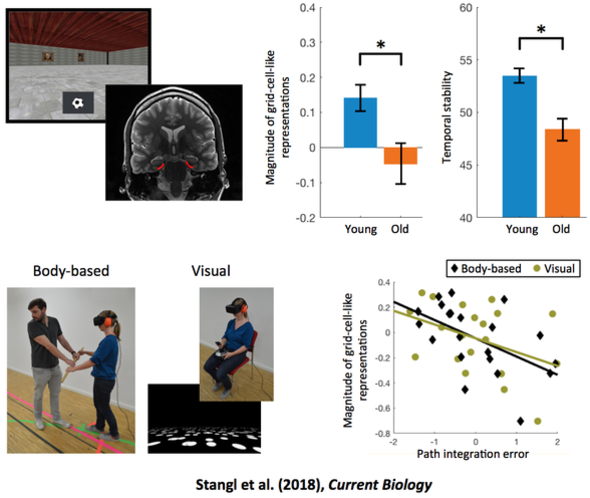How aging and preclinical dementia affect our sense of direction
In surveys, elderly people often report substantial declines in navigational abilities, which can severely restrict their mobility and affect (physical) activity and social participation. In addition, getting lost is often one of the earliest signs of dementia disorders, hence indicators of navigational functioning could potentially serve as biomarkers to identify those at risk of developing dementias.
At present, the precise navigational impairments experienced by the elderly – and the underlying neuronal mechanisms – are poorly understood. In our research, we combine ultra-high field neuroimaging, mobile EEG and behavioural experiments to shed light on these problems. This work is instrumental for detecting early signs of navigational deficits and for developing rehabilitative treatments. For example, we recently showed that the putative firing of grid cells (i.e. grid-cell-like representations) is compromised in older adults, and that these age-related changes in grid cell firing might explain path integration deficits in old age (see Figure).

Compromised grid-cell-like representations as a key mechanism to explain age-related path integration deficits.
Upper panel: Older adults showed compromised grid-cell-like representations in the entorhinal cortex (brain area highlighted in red) during navigation in a virtual environment. Specifically, magnitudes of grid-cell-like representations were reduced and grid orientations were less stable over time in older relative to young adults.
Lower panel: In a behavioral path integration task, participants had to keep track of their own position in space based on body-based or visual self-motion cues. We found that older adults showed modality-independent deficits in this task, and that their task performance was associated with their individual magnitude of grid-cell-like representations. Together, these results indicate that impaired grid cell function may play a key role in age-related decline of navigational functions.
Key references:
- Stangl, M., Achtzehn, J., Huber, K., Dietrich, C., Tempelmann, C., & Wolbers, T. (2018). Compromised grid-cell-like representations in old age as a key mechanism to explain age-related navigational deficits. Current Biology, 28(7), 1108-1115.
- Lester, A. W., Moffat, S. D., Wiener, J. M., Barnes, C. A., & Wolbers, T. (2017). The Aging Navigational System. Neuron, 95(5), 1019–1035.
- Wiener, J.M.; de Condappa, O.; Harris, M.A. & Wolbers, T. (2013). Maladaptive bias for extrahippocampal navigation strategies in aging humans. Journal of Neuroscience, 33(14): 6012-6017.

